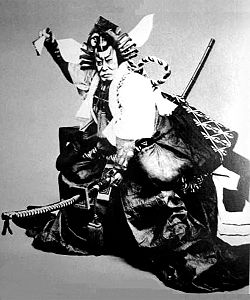Shibaraku
| Shibaraku 暫, しばらく | |
|---|---|
 A Shibaraku scene, Utagawa Kuniyoshi | |
| Written by | Ichikawa Danjūrō line |
| Characters | Kamakura Gongorō Kagemasa, Kiyohara no Takehira, Prince Kamo Jirō Yoshitsuna, Princess Katsura-no-mae |
| Date premiered | 1697, Nakamura-za, Edo |
| Original language | Japanese |
| Genre | aragoto jidaimono |
| Setting | Tsurugaoka Hachimangū, Kamakura |

Shibaraku (暫, しばらく) is among the most popular pieces in the Kabuki repertoire, and one of the celebrated Kabuki Jūhachiban (Eighteen Great Plays). The flamboyantly dramatic costume and makeup (kumadori) used in this scene is famous and widely associated by the average Westerner with Kabuki in general. The English translation of the title is akin to "Stop a Moment!"
Originally staged by Ichikawa Danjūrō I in 1697 at the Nakamura-za, it was very popular, and quickly began to be included at the annual kaomise celebrations of each theatre in Edo. For a time, the main role was frequently different, depending on the whims of the theatre and the troupe. The piece was standardized somewhat in the early 19th century by Danjūrō VII, and reworked again by Danjūrō IX at the end of that century. This version has been performed since then.
A scene of roughly 50 minutes, Shibaraku is not a play unto itself, but a short drama inserted during interludes or in between full plays to provide variety and maintain a certain level of energy and interest on the part of the audience. The plot centers around the figure of Kamakura Gongorō Kagemasa, who has become the stereotypical bombastic hero of the kabuki stage, with red-and-white striped makeup and strong, energetic movement. The historical Kamakura Kagemasa is famous for his bravery for having continued to fight after losing an eye in battle in the Gosannen War (1083-1087).
The climactic moment of this short work takes place when a goodly samurai is being assaulted by a number of villains. Kagemasa shouts "Shibaraku!" (Stop a moment!) loudly from behind a curtain (agemaku) and then steps out onto the hanamichi (a raised platform extending through the audience to the stage) in magnificent costume and makeup. Arriving at the stage, he sits on a stool (aibiki) and, in a special kind of monologue called tsurane, explains his story. He then drives the villains off and, as the curtain falls, greets the audience from the hanamichi, not as the hero, but as the actor. The work is derived from an actual occurrence involving Danjūrō I. On this particular occasion, when his fellow actors refused to give him his cue to make his entrance, Danjūrō dramatically shouted "Shibaraku!", and stepped onto the hanamichi, making his entrance.[1]
In 1746 or so, a parody called Onna Shibaraku emerged, which follows the same plot, but with a female role in place of the hero. This piece, too, became standardized, and now follows the form established by Nakamura Shikan V in 1901. The idea of parody is central to the origins, and the nature, of kabuki. This arrangement also allows onnagata, actors devoted to playing female roles, to take part in this most popular of dramatic archetypal stories.
References
- ^ Shinbashi Enbujo: Hatsuharu Hanagata Kabuki: Narukami Fudō Kitayama-zakura. (Theatre Program) 2008: Shōchiku K.K., Tokyo. p57.
- Shibaraku at Kabuki21.com
- Miyake, Shutarō (1971). "Kabuki Drama." Tokyo: Japan Travel Bureau, Inc.
